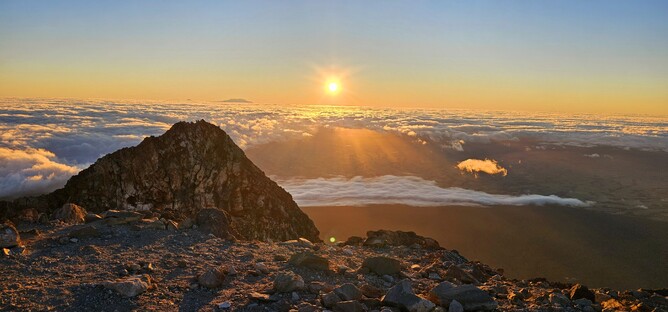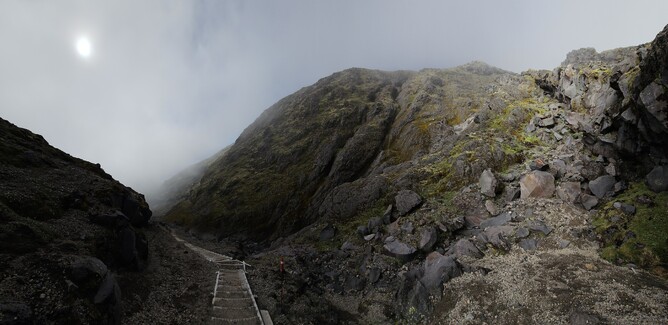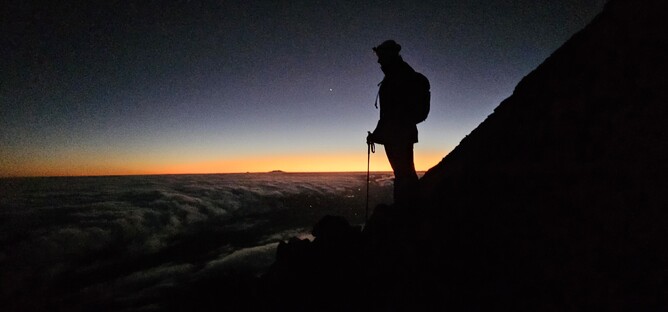6 - 10 hrs one way | 6.3km | North Egmont National Park
If you have ever flown from Auckland to the South Island (or back) and had the good fortune to sit on the correct side of the airplane you would likely have spotted Taranaki towering up through the almost perfectly circular green forest and dominating the landscape around it. It is a beautiful mountain and one that attracts many visitors, some of whom seem completely unaware of the fact that conditions can change up there very quickly and so come in completely unprepared. The summit track is a great track for those with adequate experience and carrying the right gear, but really shouldn't be attempted in poor conditions or if you haven't got the necessary awareness of the terrain and skills to cope with it. There is good information on the Mountain Safety Council website to help you decide if it is a track for you as well as checking in with DOC, so there is no shortage of information available.
I have been up to the summit twice for sunrise and love this way of doing it as watching the light flood across the landscape from the top of this Mountain is pretty special. It also means you head up in the dark and then the return back down seems like an entirely different track rather than an out and back, so you almost pretend that it is a loop.
I was a lot more prepared the second time in terms of both my fitness and ability to cope with the physical demands of the track, as well as tightening up my planning. I decided to stay at The Camphouse which is a Hut right at the base of the mountain. A fantastic DOC Hut that is bookable and makes the early morning that much more palatable. From here, you can walk directly to the start of the track and make your way up the four-wheel drive section which winds slowly up the base of the mountain without the need for driving anywhere. If you stay off the Mountain, then you will have at the very least a 30 minute drive in - and at that time in the morning any extra minute in bed counts in my opinion! There is nothing too challenging in the opening stage of the track and if you have a bit of moonlight like I did, you may also get some good views of the mountain.
This summit attempt was in February and so I set off at 3am in the hope of making it to the top for a 7am sunrise. It was forecast to be a beautiful day and the night was clear and starry but the evening before had been overcast and as I drove up the road to the Camphouse I found myself in a thick layer of cloud. Sometimes you just have to have faith that the weather forecast is right and on this occasion thankfully, the cloudy evening made way for a stunning night. This made it an enjoyable walk from the very start. Taking these things in is what makes tramping so special for me – a chance to escape the rush of everyday life and appreciate the little things ...and what better way to do that than staring up at a galaxy and mountain that have the ability to make you feel incredibly small!
Back to reality and the task at hand...I was negotiating the last part of the four-wheel drive track which is my least favourite part of the entire climb - it is steep, relentless and for whatever reason on both occasions this has been the part that nearly broke my motivation to continue. Fortunately, the key word here was "nearly" as I pushed on to the first planned stop on the track - Tahurangi Lodge (1,492 m). The picture below was taken on my way back down and shows what a beautiful landscape you have to enjoy when you get to see it on your return (and what you see from the plane when you are looking down), something you are oblivious to in the darkness as you push your way up!
The track becomes more technical and with that more challenging from the Lodge onwards. However, for me the variance of the terrain and having to think about what you are doing makes it more enjoyable than the four-wheel drive section. So once I make it here, I know that it is going to be a good day.
As I sat on the benches by the hut and started to adjust my layers in anticipation of the additional warmth I was expecting to generate as I moved on, I met a couple of brothers that had also been staying at the hut the night before and had set off slightly before me. One of them had made the decision that he couldn’t continue and so sensibly would head back down, whilst his brother asked to join me on my ascent as he had never been before. So now the group had doubled in number (which in real terms, means double the number of snack options on offer!) and after brief introductions, off we went.
We followed the track as it wound its way up the gully behind the hut and then crossed over to the other side before taking us past giant rock cliffs that towered above us. After no time at all we arrived at the start of the stair section. On the way back down, I felt relief for reaching the stairs as that makes the descent a much more pleasant experience for the legs, however, on the way up they seem to go on forever and you’re searching for the end before you have even started really. I should have been careful for what I wished for though, as all of a sudden the end of the stairs arrived and onto the scree it was! And about 30 minutes into the scree section I was wishing to be back on the stairs! Why do we do these things again?!
The scree section is the most challenging part for most people. Part of the reason I like to go up before dawn is that the scree has seemed to be a bit more compact through the cold and so I haven't felt like I am taking one step forwards and two steps back (this could just be my imagination however!). On this occasion the wind started to build up a little as the morning progressed and so we stopped frequently to adjust layers. The breaks were also good to restore some energy and get snacks on board. We were progressing well in terms of time, so no need to rush at this point and we took the chance to watch the moon setting behind the mountain.
The next section you are looking out for is known as the Lizard thanks to its lizard-like shape holding on to the side of the mountain. A little bit of relief sets in that you are now on more solid ground and the challenge now becomes related to finding footholds to clamber up through the rock. This is my favourite part of the track as you can use hands and feet and progress fairly quickly up the mountain. Every now and again I took a look back to enjoy the first bit of red lighting up the horizon and Ruapehu poking up through the mist in the distance as it then becomes a race against time to make it up in time for sunrise.
It wasn’t long before we arrived at the crater. A steep climb up to a little ledge that leads you from the outside to the inside of the crater opened up views of the snow that filled the crater year-round. Carefully picking my way down to the snow I tried to work out which route back up the inside of the crater to the summit I should choose. I have never taken the same route up and down and I don't think there is a "better" option - just go slowly and follow one of the many tracks up. Once at the top the reward is priceless. 360 degree views out across to the Tasman Ocean on one side and across to the Central Plateau on the other. The summit stands at 2,518m. Out of respect for the local traditions you are not permitted to stand on the summit itself but you get very close and there are plenty of places to explore whilst up there to take it all in.
If you get a good day, you can expect to see the triangular shadow of the mountain stretching out across the landscape below. It is awe inspiring and I could spend hours up here, but reality kicked in as well as the knowledge that the descent takes about the same time as the ascent (unless you are one of those people that can hop your way down the scree without putting the brakes on!) so we reluctantly decided we should head back down.
We followed the same track back, this time in daylight and so experiencing some of the views for the first time. The most challenging part of the descent for most is probably the scree section. It is an uncomfortable feeling having the ground fall away beneath you and given the length of time you are walking on this type of terrain up and down it is worth having had experience of it prior to attempting this track, otherwise it could be a really unenjoyable experience.
There is plenty of safety advice available for this track through DOC and the MSC so make sure you check it out before deciding to do this track and check in with DOC ahead of your climb to make sure the conditions are favourable. If you are staying at The Camphouse and making a sunrise summit attempt then my tip would be to book two nights. That way you can leave your stuff in the hut and return post-walk to have a shower and little nap before heading off or staying an additional night to recover from what is a 6-10 hour day depending on your speed. There is no doubt that this is one of the most spectacular walks on the North Island and so if you do get the opportunity to do this safely then it will not disappoint!
Parking: North Egmont Visitors Centre can be accessed easily by road all year round.
Overnight Options: The Camphouse which is a bookable 34 Bunk DOC Hut located at the North Egmont Visitors Centre and provides a good base for starting your climb. Flushing toilets and showers available here.













